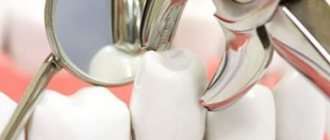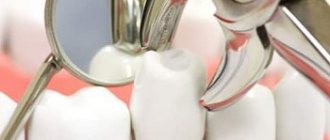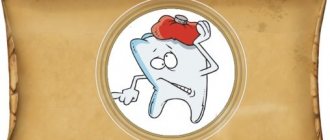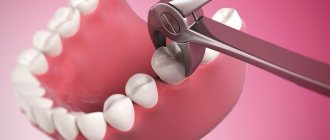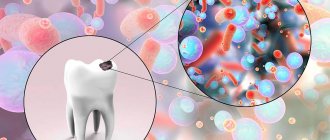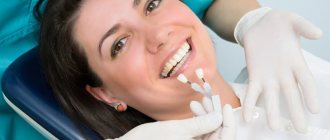Among the many diseases of the oral cavity, dental caries is the most common. According to WHO statistics, the incidence of caries in adults ranges from 80 to 98% in different countries. In this article we will tell you about caries - what is it and how to treat it?
In this article
- How does dental caries occur?
- How to treat dental caries in adults?
- How is caries treated without drilling?
- How is caries treated using the ICON method?
- How is caries treated with laser?
- How to treat caries step by step
How does dental caries occur?
At least once in their life, everyone has been to the dentist and had their teeth treated, but not many people know what dental caries is as a pathological process.
It develops when bacterial biofilm (plaque) converts sugars from carbohydrate foods into organic acids. The latter work as solvents of tooth enamel and dentin, consistently destroying the tooth structure. With a large amount of plaque, increased production of acids occurs, which leads to the rapid development of caries.
Thus, if a person consumes large quantities of carbohydrates for a long time, neglects brushing his teeth or does not remove plaque well, the body does not receive minerals in the required quantities, and the teeth are destroyed. First, a small focus of demineralization appears on the enamel, which looks like a light spot, then a cavity appears in the enamel layer. If the teeth are not cured at this stage of superficial caries, the destruction affects the dentin - it goes into the stage of first medium and then deep caries. The stronger and deeper the carious lesion, the more difficult and painful the treatment of caries will be, the greater the risk of complications, including tooth loss. Therefore, it is important to treat it immediately when the first symptoms appear.
Types of modern anesthesia
Application - local use of an anesthetic spray or gel.
Applicable:
- During professional teeth cleaning;
- When removing baby teeth;
- When removing fragments of a damaged tooth.
Infiltration. An anesthetic is injected into the apex of the tooth root. As a result, the nerve endings are blocked and the teeth lose sensitivity. The anesthesia method allows you to:
- Complete treatment of upper jaw teeth;
- Treatment of the anterior teeth of the lower jaw;
- Minor operations on the alveolar process.
Conduction - injection of medication to the branches of the trigeminal nerve. As a result, the transmission of the nerve impulse is blocked.
Used:
- When treating lower jaw teeth;
- If it is impossible to use other methods due to the inflammatory process.
This technique is difficult to perform and can cause pain, but the result is a lasting effect for a long time.
How to treat dental caries in adults?
Caries is treated in two main ways - invasive and non-invasive. The first option involves preparing a carious cavity by drilling with dental burs. The second option is more gentle and does not involve the penetration of instruments into the tooth. In essence, this is an option without drilling teeth.
It is impossible to say that one of these methods is better and the other worse, because they solve different problems. Non-invasive methods for treating caries in adults help only if the damage is minor and the disease is in an early stage. Much more often, patients turn to the dentist with moderate caries (sometimes deep), when it is impossible to properly cure the tooth without invasive intervention.
Ways to relieve toothache
If visiting a doctor is impossible for some reason, then there are ways to relieve pain at home. For some time, the listed methods provide relief, allow you to forget about the problem and calmly go about your business, but do not exclude the cause of the recurrence of toothache. Therefore, visit the dentist as soon as possible.
So, if your tooth hurts, take a painkiller, widely known and sold at the pharmacy. If there is no pharmacy, use iodine - moisten a cotton swab with two or three drops and place it on the painful area. The effect of this method is short-lived - toothache will be relieved for a maximum of five hours.
Another way is to use tinctures and decoctions. For toothache, a decoction of sage is effective (one tablespoon per 200 mg of boiling water, leave for 20 minutes, tightly closing the mug on top). Rinse your mouth with the resulting mixture. An infusion of chamomile is also effective - pour boiling water over one teaspoon of chamomile and leave for ten minutes, then rinse your mouth with the decoction. It is necessary to rinse at least five times a day. To rinse your mouth for toothache, you can use soda - add a teaspoon of salt or soda to one glass of water.
If a tooth hurts, place a piece of cotton wool soaked in alcohol in your ear on the side of the painful tooth, this will help relieve the pain.
If you have a toothache, you should absolutely not heat the sore spot. Heating it can only lead to the development of pain and an increase in the inflammatory process.
Remember that toothache is a symptom that some kind of inflammatory process has already begun in the oral cavity. Do not hesitate and do not get carried away with home treatment, but immediately make an appointment with the dentist.
To ensure that the question of what to do for toothache arises as rarely as possible, visit the doctor yourself twice a year. Our Dentistry on Shchelkovskaya has a system of appointment reminders, so you definitely won’t miss a preventive examination. Make an appointment now by calling 8 or using the online appointment form. We are located near metro station Shchelkovskaya.
How is caries treated without drilling?
Many adults are even more afraid of dentists than children, and prefer to treat dental caries using non-invasive methods, without the use of dental burs. Conservative treatment without drilling teeth can be carried out using several methods.
The first option is remineralization. When caries just begins to affect the tooth enamel, a small white spot forms on it. This is the focus of demineralization - the zone in which the loss of mineral components of the enamel began. If you notice a change in enamel color in time and contact your dentist, your doctor may prescribe remineralization therapy to restore mineral balance. The dentist treats the patient’s teeth with special fluoride and calcium-containing preparations, makes medicinal applications, or prescribes home use of medications with a similar effect. Deep fluoridation is considered the most effective method of remineralization therapy.
Pastes for filling
In order to fill dental canals, different pastes are often used. They are used to seal voids in the tooth cavity after the pulp has been removed. Today the most popular pastes are:
- formalin paste Resorcinol;
- Forfenan paste;
- Endamethozon paste.
But all pastes are very difficult to unfill if you need to re-treat the tooth. In addition, the material may be distributed unevenly; when the channel is filled, air gaps may occur. But regardless of this, such pastes are used very often for filling.
How is caries treated using the ICON method?
When dental caries in adults is in the staining stage, it can be treated with a non-invasive infiltration method. This technology allows you to stop the spread of carious lesions deep into the tooth without the use of a drill.
Caries is treated according to the following scheme:
- The dentist removes plaque and other deposits from the surface of the tooth enamel.
- A special etching gel with hydrochloric acid is applied to the affected area.
- Within two minutes the surface layer is removed;
- After two minutes, the gel is washed off with an air-water jet, the surface is dried and washed with an ethanol solution to remove residual moisture from the porous areas of the tooth. At the final stage, the tooth is covered with a composite material that seals the pores of the tooth enamel.
The main advantages of the method: it is possible to treat both caries of permanent teeth and baby teeth for children.
The treatment is absolutely painless, so no anesthesia is needed. Healthy areas of dental tissue are preserved during treatment. You can quickly and easily treat carious lesions on several teeth in one visit. The procedure takes no more than 15 minutes.
Filling materials
They can be very different. The most important thing when filling is to close the holes that have formed in the tooth. It is also necessary to restore the functions of the tooth. Therefore, when choosing a material, the location of the tooth and the possible load are taken into account.
If the chewing tooth is severely damaged, then polymers can be used; they can withstand heavy loads. As for the anterior teeth, light-curing composites are more often used here. With their help, you can create a shade that is most reminiscent of natural. For incisors and their filling, silicate and silicophosphate cements are usually used.
Materials must meet certain requirements. They should not dissolve in dental tissues, be easy to remove if repeated treatment is needed, not enter into a chemical reaction with the tooth, and ensure complete sealing of the tooth canals.
How is caries treated with laser?
Laser treatment of caries is a modern non-contact method. The laser beam passes into the dental tissue to the depth required for treatment. It removes affected tissue, disinfects, and reduces the likelihood of bleeding. At the same time, the laser does not damage healthy tissue.
The advantages of laser treatment of dental caries are the minimal risk of complications, the ability to control the intensity and depth of the effect. With all its advantages, the laser is effective in the early stages of caries, like other non-invasive methods.
How to treat caries step by step
The algorithm is something like this:
- Plaque and dental deposits are removed from the surface of the diseased tooth and those adjacent to it. For this purpose, abrasive pastes, ultrasonic nozzles, and special brushes are used.
- The dentist selects a shade of filling material that is as close as possible to the natural color of the teeth. A special scale is used to select the tone.
- Anesthesia. Treating medium and deep caries without anesthesia is quite painful, so most patients are given local anesthesia - an anesthetic injection. The duration of its effect depends on the type and dosage of anesthesia.
- Preparation of a carious cavity. At this stage, the doctor drills out the affected tooth tissue, removing destroyed dentin and the edges of the enamel hanging over the cavity. If the dentist violates the technology and leaves at least part of the affected tissue under the filling, the patient will develop secondary caries, and if the crown is completely destroyed, pulpitis and periodontitis.
- Isolation of a diseased tooth. To properly fill a tooth, it must be dry. Therefore, dentists use a rubber dam (a special plate) to protect the tooth from saliva. The quality of insulation directly affects the service life of the seal.
- Treatment of the tooth cavity with antiseptics for thorough disinfection.
- Reconstruction of the side wall. If the carious lesion is located in the area between the teeth, the tooth wall must be restored before installing a filling.
- Acid etching and adhesive application. These manipulations are necessary in order to increase the adhesion of the cavity walls and the filling material and ensure reliable fixation of the filling.
- Installation of therapeutic or insulating pads. Therapeutic ones are given in the presence of inflammation; insulating ones are needed to prevent shrinkage of the filling and its negative effect on the tooth tissue.
- Filling. Today, photopolymer composites are used in most cases. They are applied layer by layer and illuminated with a lamp to harden the material. Photopolymer composites are good because they almost do not shrink, have high strength and reliability.
- Bite adjustment, grinding and polishing. The doctor adjusts the size and shape of the filling so that when it comes into contact with the teeth of the opposite row, the filling does not interfere, and the jaws can close normally. At the end of the procedure, the dentist grinds and polishes the surface, removing all unevenness and roughness and giving the filling an aesthetic appearance.
Thus, caries in adults can be treated in different ways. The choice of method depends on the stage of the disease, tolerance to anesthesia and a number of other factors. It is important to remember that the sooner you see a doctor, the simpler and faster the treatment will be.
Features of filling anterior teeth
Quite often people come in whose front teeth have been damaged by caries. The reasons may be lack of proper care, heredity, poor nutrition. Initially, it is a dark spot that is difficult to notice. It can be located between the teeth or on the inside of the tooth. But the dentin layer on the front teeth is too small, so the stain becomes larger and larger. The most important thing is to see a doctor in time.
Ceramic fillings are often placed on the front teeth. They are expensive, but this method is considered advanced. In appearance they do not differ from other options, but this material has excellent resistance to external factors. But it takes a lot of time to make such a filling. Therefore, it is used only in cases where severe damage to the tooth has occurred and it is not possible to use a light filling.
